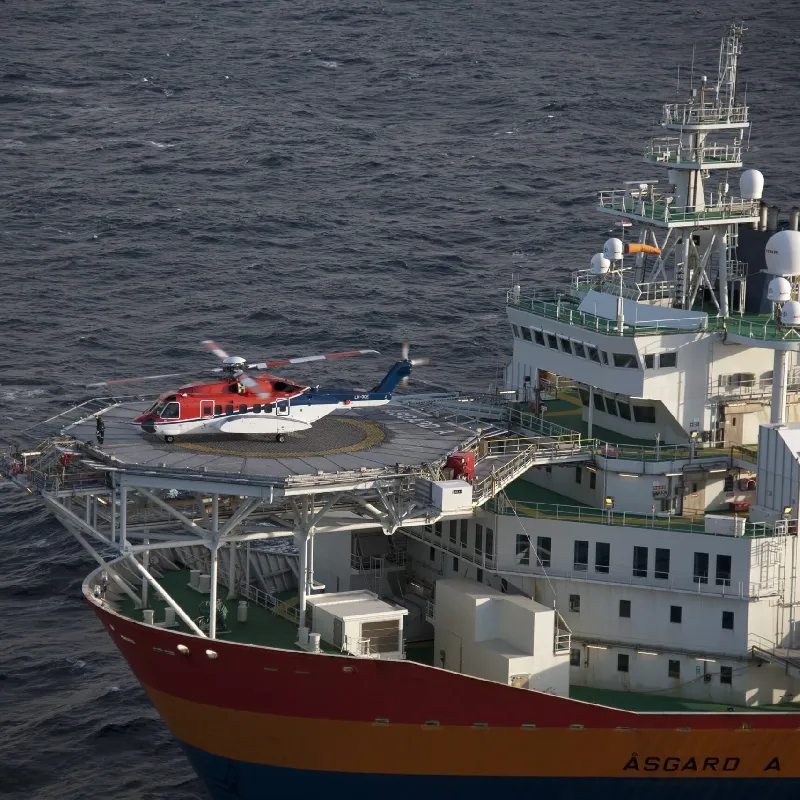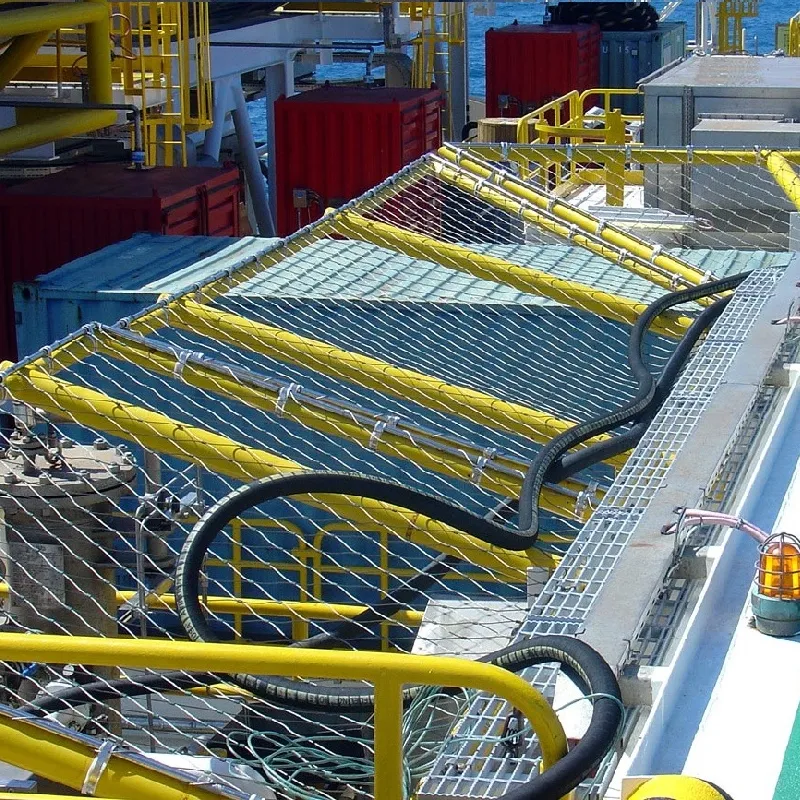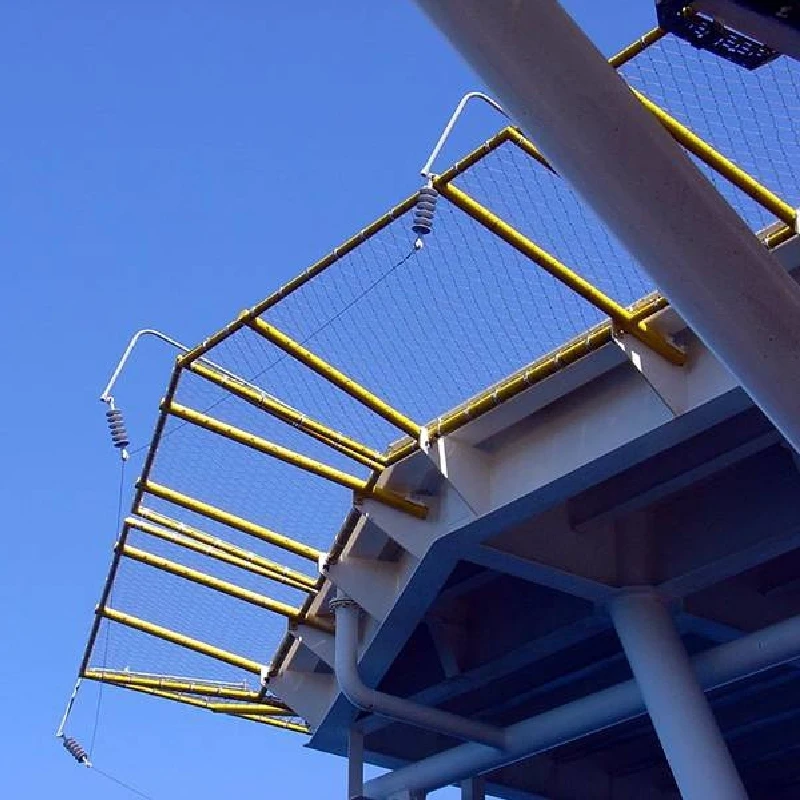- Industrial zone, South of Anping Town, Hengshui, Hebei, China.
- sales@hfpetromesh.com
- +86-18931809706
Oct . 27, 2025 11:45
Back to list
Helideck Perimeter Safety Nets – IMO, Marine-Grade
I’ve stood on more offshore helidecks than I can count, and one detail that never feels trivial is the quiet certainty of the perimeter net. If you’ve ever watched a rotor wash kick up kit bags and hats, you already know why. Helideck Perimeter Safety Nets aren’t flashy; they’re the last line of defense between people, equipment and open sea. And lately, the industry seems to be moving toward lighter, corrosion-proof systems that can be inspected fast and retrofitted without drama.
 Trend snapshot—because people ask: stainless-steel wire-rope mesh is edging out traditional synthetic rope on harsh offshore assets; modular aluminum frames keep weight down; and more clients want documented drop tests plus salt-spray data (to be honest, auditors are pushing this). Hospitals and rooftop pads still feature, but offshore O&G, wind O&M vessels and platforms are the big adopters.
Trend snapshot—because people ask: stainless-steel wire-rope mesh is edging out traditional synthetic rope on harsh offshore assets; modular aluminum frames keep weight down; and more clients want documented drop tests plus salt-spray data (to be honest, auditors are pushing this). Hospitals and rooftop pads still feature, but offshore O&G, wind O&M vessels and platforms are the big adopters.
 Process and testing—how it actually gets done:
- Materials: SS316/316L wire rope, swage ferrules, marine-grade frames; all sourced with mill certs.
- Fabrication: mesh cut-to-size; hydraulic swaging; frame welding; trial fit; passivation/HDG; assembly with lacing or clamps.
- Testing: salt-spray (e.g., ASTM B117) to demonstrate coating/corrosion resistance; sample proof-load on mesh panels; drop/impact simulations per client spec (typical in-house example: ≈100 kg bag from ≈1 m, no penetration—project approvals required).
- Documentation: MTRs, WPS/PQRs (if welded), dimensional checks, QA sign-off.
- Compliance pathway: designed to align with CAP 437 and relevant heliport/helideck guidance; local authority acceptance is always the final word.
Where they’re used:
- Offshore platforms, FPSOs, and wind farm SOVs/CSOVs
- Jack-ups and liftboats (retrofits are common)
- Hospital and rooftop heliports (subject to local codes; sometimes guardrails + nets)
Advantages we keep hearing about:
- High catch performance with low visual bulk; minimal shadowing on deck markings
- Corrosion resistance in salt-laden air
- Modular sections for quick swap-out during shutdowns
- Weight savings vs. heavy steel mesh—pilots like clean airflow
Process and testing—how it actually gets done:
- Materials: SS316/316L wire rope, swage ferrules, marine-grade frames; all sourced with mill certs.
- Fabrication: mesh cut-to-size; hydraulic swaging; frame welding; trial fit; passivation/HDG; assembly with lacing or clamps.
- Testing: salt-spray (e.g., ASTM B117) to demonstrate coating/corrosion resistance; sample proof-load on mesh panels; drop/impact simulations per client spec (typical in-house example: ≈100 kg bag from ≈1 m, no penetration—project approvals required).
- Documentation: MTRs, WPS/PQRs (if welded), dimensional checks, QA sign-off.
- Compliance pathway: designed to align with CAP 437 and relevant heliport/helideck guidance; local authority acceptance is always the final word.
Where they’re used:
- Offshore platforms, FPSOs, and wind farm SOVs/CSOVs
- Jack-ups and liftboats (retrofits are common)
- Hospital and rooftop heliports (subject to local codes; sometimes guardrails + nets)
Advantages we keep hearing about:
- High catch performance with low visual bulk; minimal shadowing on deck markings
- Corrosion resistance in salt-laden air
- Modular sections for quick swap-out during shutdowns
- Weight savings vs. heavy steel mesh—pilots like clean airflow
 Quick vendor landscape (informal but useful):
Quick vendor landscape (informal but useful):
Customization I’d ask for on any RFQ:
- Exact band width and stanchion spacing; panel curvature for circular decks
- Aperture and cable diameter (balance airflow vs. catch)
- Interface details: brackets, hot-work limits, clamp-on options
- Finish: passivation certificates, coating system, color
- Inspection plan: what’s the acceptance criteria and re-test interval?
Case notes from the field:
- North Sea platform retrofit: swapped aging rope nets for SS316 mesh; weight down ≈18%, inspection time down ≈30%, zero object drop reports over 18 months (client feedback).
- Hospital helipad upgrade: modular aluminum frames allowed weekend install; facilities team said “maintenance went from fiddly to predictable.”
 By the way, HF Petro Mesh manufactures in the industrial zone, south of Anping Town, Hengshui, Hebei, China—supply chains are stable, and packaging is ship-safe, which matters when a storm delays offloading. If you’re scoping Helideck Perimeter Safety Nets for offshore duty, pin your design to current guidance, insist on documented corrosion and impact tests, and don’t forget spare panels—it seems obvious, but many customers say that’s what saved a shutdown.
References (authoritative):
1. UK CAA, CAP 437: Offshore Helicopter Landing Areas – Guidance on Standards. https://www.caa.co.uk/cap437
2. ICAO Annex 14, Volume II – Heliports. https://store.icao.int/en/annex-14-aerodromes-volume-ii-heliports
3. IMO – MODU Code (Helideck provisions). https://www.imo.org/en/OurWork/Safety/Pages/ModuCode.aspx
4. NFPA 418 – Standard for Heliports. https://www.nfpa.org/codes-and-standards/list-of-codes-and-standards/418
5. ABS Rules and Guides – Helicopter Facility Design (guidance). https://ww2.eagle.org/en/rules-and-resources/rules-and-guides.html
By the way, HF Petro Mesh manufactures in the industrial zone, south of Anping Town, Hengshui, Hebei, China—supply chains are stable, and packaging is ship-safe, which matters when a storm delays offloading. If you’re scoping Helideck Perimeter Safety Nets for offshore duty, pin your design to current guidance, insist on documented corrosion and impact tests, and don’t forget spare panels—it seems obvious, but many customers say that’s what saved a shutdown.
References (authoritative):
1. UK CAA, CAP 437: Offshore Helicopter Landing Areas – Guidance on Standards. https://www.caa.co.uk/cap437
2. ICAO Annex 14, Volume II – Heliports. https://store.icao.int/en/annex-14-aerodromes-volume-ii-heliports
3. IMO – MODU Code (Helideck provisions). https://www.imo.org/en/OurWork/Safety/Pages/ModuCode.aspx
4. NFPA 418 – Standard for Heliports. https://www.nfpa.org/codes-and-standards/list-of-codes-and-standards/418
5. ABS Rules and Guides – Helicopter Facility Design (guidance). https://ww2.eagle.org/en/rules-and-resources/rules-and-guides.html

Product at a glance (Perimeter Safety Netting)
| Parameter | Typical Option/Value (≈, real-world use may vary) |
|---|---|
| Net material | 316/316L stainless wire-rope mesh (7x7 / 7x19), or UV-stabilized PA/PE rope (project-dependent) |
| Frame/stanchions | Marine-grade aluminum (e.g., 6000-series) or hot-dip galvanized steel; custom bases |
| Panel width | Around 1.5–2.0 m band around the deck edge (per project standard) |
| Mesh aperture / cable Ø | ≈50–100 mm aperture; ≈3–5 mm cable |
| Finish | Pickling/passivation for SS; HDG or marine coating for steel; color coding optional |
| Service life | Up to 10–15 years offshore with SS and planned maintenance (environment-dependent) |


| Vendor | Core Material | Certs/Docs | Lead Time | Notes |
|---|---|---|---|---|
| HF Petro Mesh (Perimeter Safety Netting) | SS316/316L wire-rope mesh | Mill certs, QA pack; aligns with CAP 437/ICAO guidance | ≈3–6 weeks (project size dependent) | Custom geometries; offshore-focused |
| BrandX Offshore Nets | HDG steel + synthetic rope | Factory QA, test reports on request | ≈4–8 weeks | Budget-friendly, heavier systems |
| EuroHeli Safety Systems | Alu frames + SS mesh | CE-like dossiers; client FATs possible | ≈5–10 weeks | Strong in EU specs; bespoke brackets |

Share
Latest news
-
Shaker Screen for Sale – Durable, API-Rated, Fast ShippingNewsNov.17,2025
-
Industrial Steel Grating — Durable, Anti-Slip, GalvanizedNewsNov.17,2025
-
Industrial Steel Grating: Durable, Anti-Slip, GalvanizedNewsNov.17,2025
-
Shale Shaker Screen – Durable Mesh, Factory Price, OEMNewsNov.17,2025
-
Shale Shaker Screen Factory | API Quality, OEM, Fast ShipNewsNov.17,2025
-
Metal Grating for Sale – In Stock, Custom Sizes, Quick ShipNewsNov.10,2025